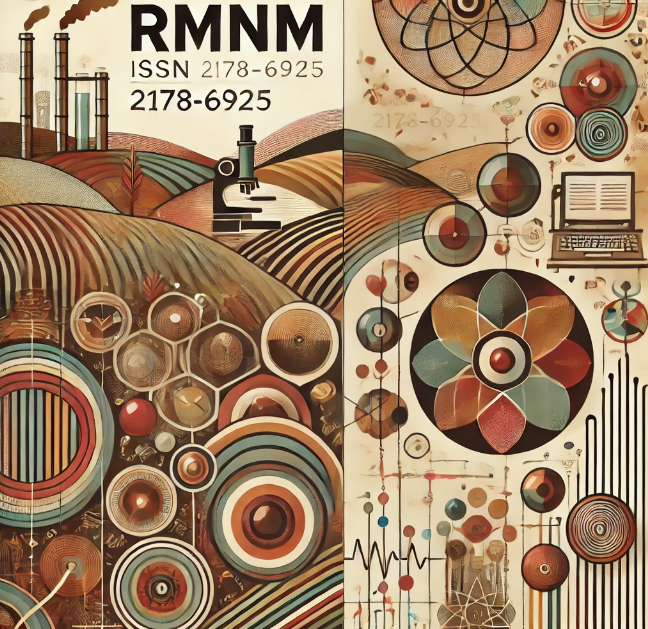ANÁLISE COMPARATIVA DA LIBERAÇÃO DE FLÚOR POR CIMENTOS DE IONÔMERO DE VIDRO CONVENCIONAIS E MODIFICADOS POR RESINA: UM ESTUDO IN VITRO
DOI:
https://doi.org/10.61164/rmnm.v4i1.2295Palabras clave:
Forramento da cavidade dentária, Cimentos de Ionômeros de Vidro, Flúor, Materiais DentáriosResumen
O objetivo deste estudo foi comparar a taxa de liberação de flúor do Cimento de Ionômero de Vidro (CIV) Convencional e o Cimento de Ionômero de Vidro Fotoativado, bem como inferir a influência da proteção superficial do material com verniz cavitário nessa liberação. Com uma metodologia in vitro, um total de 84 corpos de prova foram divididos em dois grupos: Grupo 1 (CIVC) e Grupo 2 (CIVF). Foram criados três subgrupos (n=14) para cada grupo: para cimentos convencionais - Amostra A (Vidrion R), Amostra B (Vitro Fil), Amostra C (Maxxion R), e para os cimentos fotoativados - Amostra D (FIL FIL LC), Amostra E (Riva LC) e Amostra F (Ionoseal). Após a polimerização completa dos espécimes, metade das amostras de cada subgrupo (7 amostras) recebeu uma proteção superficial com verniz cavitário (Cavitine -SSWHITE). Para comparar a liberação de flúor entre os materiais, foi aplicado o Teste t de Student para grupos independentes. Para determinar se houve diferenças significativas na liberação de flúor ao longo do tempo, foi utilizado o teste ANOVA de medidas repetidas com comparações múltiplas usando ajuste de Bonferroni. A maior liberação de flúor para os materiais com cobertura de verniz ocorreu após 28 dias (CIVC = 27,97 ± 28,12; CIVF = 15,73 ± 11,25). Para os CIV sem aplicação de verniz, a maior liberação de flúor ocorreu após 21 dias (CIVC = 21,33 ± 19,65; CIVF = 15,37 ± 16,68). Não foram observadas diferenças estatisticamente significativas entre os grupos avaliados (p > 0,05). Foi possível concluir que os CIVs liberam flúor em diferentes intervalos de tempo e a proteção superficial dos cimentos não impactou negativamente na liberação de flúor dos materiais analisados.
Citas
BASSO, GR et al. Fluoride release from restorative materials. Brazilian Dental Journal, v. 22, p. 355-358, 2011. DOI: https://doi.org/10.1590/S0103-64402011000500001
BERG, JH, CROLL, TP. Glass ionomers restorative cement systems: an update. Pediatric Dentistry Journal, v. 37, p.116-124, 2015.
BHATIA, HP et al. A Comparative Evaluation of Sorption, Solubility, and Compressive Strength of Three Different Glass Ionomer Cements in Artificial Saliva: An in vitro Study. International Journal of Clinical Pediatric Dentistry, v. 10, p.49-54, 2017. DOI: https://doi.org/10.5005/jp-journals-10005-1407
CHAU NP et al. Relationship between fluoride release rate and anti-cariogenic biofilm activity of glass ionomers cements. Dental Materials, v. 31, p. 100-108, 2015. DOI: https://doi.org/10.1016/j.dental.2014.12.016
DE CALUWÉ, T et al. Addition of bioactive glass to glass ionomer cements: Effect on the physico-chemical properties and biocompatibility. Dental Materials. v. 33, n. 4, p. e186-e203, 2017. DOI: https://doi.org/10.1016/j.dental.2017.01.007
DOUGHTY, J et al. The dental public health implications of cosmetic dentistry: a scoping review of the literature. Community Dent Health, v. 33, p.218-224, 2016.
DUQUE, C et al. In vitro and in vivo evaluations of glass-ionomer cement containing chlorhexidine for Atraumatic Restorative Treatment. Journal of Applied Oral Science, v. 25, p.541-550, 2017. DOI: https://doi.org/10.1590/1678-7757-2016-0195
FRENCKEN, JE. The ART approach usingglass-ionomers in relation to global oral healthcare. Dental Materials, v. 26, p. 1-6, 2010. DOI: https://doi.org/10.1016/j.dental.2009.08.013
HAHNEL, S et al. Biofilm formation and release of fluoride from dental restorative materials in relation to their surface properties. Journal of Dentistry, v, 60, p.14-24, 2017. DOI: https://doi.org/10.1016/j.jdent.2017.02.005
HOSHIKA, S et al. Effect of Conditioning and Aging on the Bond Strength and Interfacial Morphology of Glass-ionomer Cement Bonded to Dentin. The Journal of Adhesive Dentistry,v. 17, p. 141-146, 2015.
KAMATHAM R, REDDY SJ. Surface coatings on glass ionomers restorations in Pediatric dentistry- Worthy or not? Journal of Indian Society of Pedodontics and Preventive Dentistry, v. 31, p.229-233, 2013. DOI: https://doi.org/10.4103/0970-4388.121818
KUCUKYILMAZ, E et al. Fluoride release/recharging ability and bond strength of glass ionomers cements to sound and caries-affected dentin. Nigerian Journal of Clinical Practice, v. 20, p. 226-234, 2017. DOI: https://doi.org/10.4103/1119-3077.178917
KUMAR, RS et al. Nanochitosan modificado vidro ionómero cimento com propriedades mecânicas melhoradas e fluoreto de libertação. International Journal of Biological Macromolecules, S0141-8130(16) 32665-4, 2017.
RANADHEER, E et al. Comparative Analysis of Microleakage of Zirconia-infused Glass Ionomer Cement with Miracle Mix and Amalgam: An In Vitro Study. Cureus, v. 10, p. e3672, 2018. DOI: https://doi.org/10.7759/cureus.3672
SHIOZAWA, M et al. Fluoride release and mechanical properties after 1-year water storage of recent restorative glass ionomer cements. Clinical Oral Investigations, v.18, p.1053–1060, 2014. DOI: https://doi.org/10.1007/s00784-013-1074-4
WIEGAND, A et al. Review on fluoride-releasing restorative materials, fluoride release and uptake characteristics, antibacterial activity and influence on caries formation. Dental Materials, v. 23, p. 343-362, 2007. DOI: https://doi.org/10.1016/j.dental.2006.01.022
ZHITKOV, MY et al. Comparative in vitro evaluation of modern glass ionomers cements for adhesion strength and fluoride release. Stomatologiia (Mosk), v. 95, p.58-62, 2016. DOI: https://doi.org/10.17116/stomat201695258-62
Descargas
Publicado
Cómo citar
Número
Sección
Licencia
Derechos de autor 2024 Revista Multidisciplinar do Nordeste Mineiro

Esta obra está bajo una licencia internacional Creative Commons Atribución-NoComercial-CompartirIgual 4.0.




